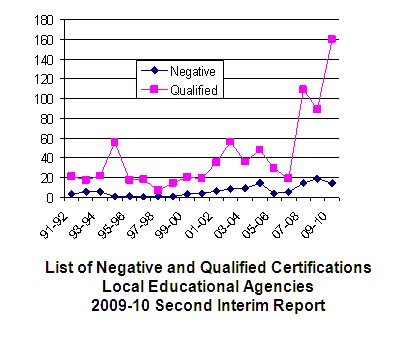O’Connell, Pugh decry state budget impacts on LEAs
LEAs with qualified or negative budgets climbs 38% since January
Published: June 29, 2010
The state’s continuing budget crisis and the cumulative effects of more than $17 billion in cuts to education over the past two years have caused the number of local educational agencies threatened with insolvency to spike by 38 percent – and that’s just since January.
As of March 15, the number of school districts and county offices of education on the state’s watch list rose to 174, up from 126 in January. That represents about 16 percent of the state’s LEAs that have negative or qualified budgets as of the second interim status report.

“Schools on this list are now forced to make terrible decisions to cut programs and services that students need or face bankruptcy,” state Superintendent of Public Instruction Jack O’Connell said today in Sacramento. “I have grave concerns that more and more school districts will face financial crisis unless state lawmakers find solutions to the state budget crisis and provide adequate funding for our schools.”
Of the 174 LEAs on the list, 160 have “qualified” budgets, which means they may not be able to meet their financial obligations for two years. The increase in the number of qualified budgets alarmed O’Connell.
“Our school board members and school administrators … know that the cuts they are being forced to make are not in the best interests of their students,” he said. “What we’re experiencing now are cuts upon cuts upon cuts.”
CSBA President Frank Pugh, whose own Santa Rosa City Schools board must slash $20 million from the district’s budget this year and next, said the situation is the worst he’s seen in 20 years as a board member and 32 years as a teacher.
“These unprecedented cuts are changing the face of education for an entire generation of students,” Pugh said. “Educational programs have been cut to the bone and quite honestly, some of them have been cut down to the marrow.”
For the 14 agencies with a negative certification, they must take swift action to resolve their budget deficit or face takeover by a state administrator if they are forced to ask the state for a loan. Such an eventuality would not be good for anyone, O’Connell said.
Next year may be worse yet. Without the boost from federal stimulus funds and flexible use of categorical dollars, which is due to expire next year, the list is likely to be even longer.
The situation is heartbreaking for board members trying to look out for children’s best interests while scrambling to keep the district afloat, Pugh indicated.
“Parents want to believe that somehow things are going to work out for the benefit of their kids. The fact of the matter is, board members are put in the difficult situation to assume the worst, because quite honestly the worst is what we’ve been experiencing for years now,” Pugh said after the announcement.
“It’s extremely difficult to imagine the kind of cuts we have to make—limiting music programs or libraries … art programs and career technical education experiences—we can’t imagine these horrific cuts, yet we have to do that because of what our responsibilities are. We’re charged to create a balanced budget, but I will tell you: right now we’re hand to mouth.”
Easy link: